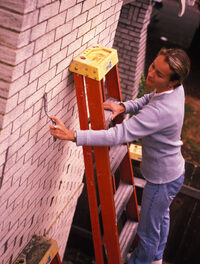 In the UK every single year there are accidents related to falling from height that could and should have been avoided. In total, between 2013 and 2014 there were nearly 3,000 incidents where employees were injured from falls from height. Of that figure, 39 people died; that’s 39 people whose lives may have been saved if they had been following correct safety precautions or provided with the correct equipment. The majority of the accidents come from falls from ladders, something that easily could have been avoided if they either had proper training, or were using this equipment as it is intended.
In the UK every single year there are accidents related to falling from height that could and should have been avoided. In total, between 2013 and 2014 there were nearly 3,000 incidents where employees were injured from falls from height. Of that figure, 39 people died; that’s 39 people whose lives may have been saved if they had been following correct safety precautions or provided with the correct equipment. The majority of the accidents come from falls from ladders, something that easily could have been avoided if they either had proper training, or were using this equipment as it is intended.
Ladders are not designed to be used as platforms to be working from. Ladders should only be used to access areas at height. The stability of a ladder relates directly to the size of its footprint, its height, and your actions when using it. By moving your body anywhere outside the frame of the ladder you are risking the stability of the ladder, and with it, your life.
In these situations, conditions where we need to be working at height and there are no fixed, permanent structures for solid footing, it is imperative that you choose to use a DIY scaffold tower. On construction sites this ethos is drilled into employees due to the safety factor, but in homes all over the country, for some reason this issue is often overlooked. One of the most common reasons for DIY accidents at home is because people do not have the proper safety equipment when tackling a job. Let me reiterate this; when working at height, a scaffold tower is an essential piece of safety equipment.
I know what you’re thinking:
- A scaffold tower is a huge set of steel or aluminium that I just don’t have space for. - You have space for a 10ft ladder, but not a 5ft by 5ft set of access tower panels?
- I have no idea how to erect a DIY scaffold tower! - It really is simple; 4 panels, a selection of diagonal and horizontal braces and a set of instructions to guide you.
- Isn’t a scaffold tower overkill? - If it massively reduces the chances of an injury or even death, is anything overkill?
The Health and Safety Executive (HSE) reported in 2011 that of all major injuries related to slips, trips and falls in the previous year, 17% of them were caused by movable or fixed ladders. When access towers are used, and erection methods and safety guidelines are properly followed, the risks associated to falling from height are virtually non-existent.
The percentage of people who, when standing at the top of a ladder, feel completely safe with what they are doing can be counted in single digits. However, many home DIY-ers still believe that their only option when carrying out work on their homes at height is to use a ladder. It’s unfounded and certainly not sensible; would you risk your life for the sake of a little extra money and a few minutes of your time?
Simply put, ladders should not be used for working at height, and if you are looking to carry out any DIY on the exterior of your house this year, please consider getting hold of a more safe and stable access solution!
Author Bio:
Martin Heaton is the owner of Heaton Products Ltd. Heaton Products supplies non-mechanical plant and equipment for the construction industry. As well as scaffold towers, Heaton Products is also the home of Trestlemate trestle guardrail system, and the Propmate wall support system.